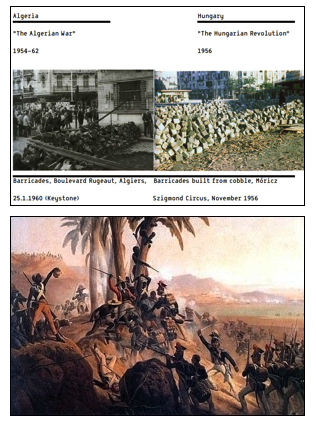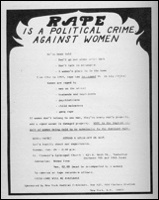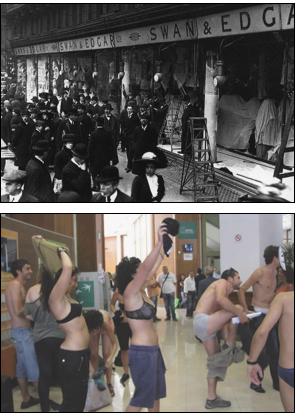Revolution : Ariella Azoulay
 The Concept as Touchstone The judgment—“this is revolution” or “this is not revolution”—voiced in various places and times by citizens, among them experts on revolution, is derived from the nature of the common concept of revolution. Instead of inviting one to ask what is revolution, it offers itself for use, ever since the eighteenth century. Thus the study of revolutions is contained within more or less clear limits that preserve the eighteenth century as the cradle of revolution, and “the American Revolution” as well as “the French Revolution” as the full embodiment of this concept. Most of the fascinating studies written in recent decades that illuminate hidden aspects of these and other revolutions have not turned back from the researched phenomena to the concept itself. They have not asked whether that which has been conceptualized and established as revolution was such indeed, and what the existing As varied and as polyphonic as the discussion and research of revolution may be, most of its participants share this one basic agreement—that the claim “this is revolution” should be made cautiously and sparingly. When I began to research the French Revolution several years ago, I did so with the kind of awe felt by anyone aware of the fact that few revolutions—if indeed they are any—that succeeded it can embody the idea of revolution as succinctly and decidedly.1 Radicalism, the guillotine, a new and sweeping fresh start, abolition of monarchy, modern citizenship, old versus new regime—what else at this time could equal it? This sparing use of the term revolution is not merely academic or theoretical. It produces its rareness and superiority over other forms of being-together that could mistakenly be perceived as similar to it—revolt, rebellion, uprising, coup, solidarity, movement, partnership, participation or protest. The forms of speech into which the concept of revolution is woven lie in wait of revolutionaries and of those who observe reality, think with and through it. Such forms induce them to minimize the events of the day, knowing in advance that what is happening in front of their very eyes does not suffice to merit the name ‘revolution’. This is a form of discursive practice, a model of producing knowledge and a regime practice, one of whose typical expressions is reading reality in comparison to the concept ‘revolution’, and judging historical events by their conforming to this concept.2 The existing concept of revolution assumes a result obtained within the given time in which it takes place—usually the creation of a new or old sovereign regime—as a basis for characterizing and establishing the kind of event at hand, and the way it is distinct from other events.3 This matter repeats itself whether regarding what is commonly seen as a ‘broad’ definition of revolution—“any and all instances in which a state or political regime is overthrown and thereby transformed by a popular movement”—or the ‘narrow’ definition, according to which “revolutions entail not only mass mobilization and regime change, but also more or less rapid The commonplace concept of revolution, which I also used at the start of my own work, un-problematically tied together an occurrence in which masses take part in a radical regime change where a new ruling power constellation is created. Parallel to my research of revolutions from the eighteenth century to the present, I also studied the history of Palestine-Israel. Numerous similarities connected the two—violence, new beginnings, and regime change—but several years went by until I managed to deconstruct and reconstruct the link between the common concepts that served to describe this history and the events they described.6 The further into my research, the harder I found it to push aside unsettling questions regarding what is—or is considered—a revolution: why was the violence exerted in Palestine in 1948 perpetuated as independence and why were the feverish efforts of Jews and Arabs to create local peace alliances dropped out of this history and not considered a potential for revolution? Why was Algeria etched in consciousness as war while Hungary designated revolution? Why have revolutions in Haiti or South Africa been characterized as rebellions or coups d’état, while the struggle for civil rights or against rape in the US were each described as movements? By insisting on regarding different states of being-together not necessarily recognized as revolutions, I could begin to conceptualize revolution less as a targeted occurrence, demarcated in time and space, and more as a collection of civil statements and formations. I began to characterize and sort them, and to study their different appearances in different places and times, but no less—their similarity, as that too was part of a distinct civil language whose contrast to the current ruling language was easily apparent. This confrontation becomes obvious when citizens are present and speak civil language in public space, and the representatives of the regime use various tools in order to limit this presence or altogether remove it from this space. The existing regime’s hostility towards such statements and formations is less obvious when it is exercised continuously by the institutions and their syntax. When civil language awakens and manages to spread in space, when it is spoken by many men and women who do not necessarily know each other, together they manage to shatter syntactic sequences in the existing ruling language and make violence visible to the naked eye. Ruling language then resembles cast iron that requires tremendous might—the power of many together—to face and When the different moments in which civil language spoken by many are no longer considered isolated events that are doomed to fail—they appear as a rich civil language. Since the eighteenth century, this language, generated by civil passion and persistence to live differently, struggles to exist against the efforts of the common The Ideic-Concept In recent years much has been written about non-white women and men’s participation in the various revolutions.8 Even if this literature were to be doubled or tripled, however, without renewed thinking about the concept of revolution, a reconstruction of lost pieces of the puzzle will not shake the idea of regime that has been stabilized out of the existing concept of revolution. Construction of a new regime means demarcating the sphere of sovereignty, declaring the end of revolution and establishing who is entitled to citizenship and who is not.9 A new conceptualization of revolution must then account for these three factors: space, time and body politic, and for the great power of those oppressive regimes that were constructed out of the eighteenth-century revolutions to render self-evident the identification of revolution with self-determination and liberty. Restoring the concept of revolution and its uses from the writing of several major thinkers of revolution has enabled me to ground my assumption that revolution is a distinct type of concept that, paradoxically, is not civil. This is an inflexible concept, even fossilized, not transformed by the phenomenal world. Rather, transformations are observed and measured in its light, as if it were a touchstone. “This is not a revolution,” Hannah Arendt would say of the French Revolution, while hailing the American one.11 “This is not a revolution,” Domenico Losurdo would say of the American Revolution and praise the French one.12 The fossilized structure of the concept brings it closer to an idea in its Platonic sense and turns it into what I propose to call an ideic-concept. Again, a wide range of revolutionary phenomena are doomed to fail in its embodiment. The negative judgment—“this is not revolution,” which the “connoisseurs” hurry to make before others—also helps to preserve the concept as an idea, shielded from phenomena that might distort it, and also helps preserve the phenomena in their minuteness, never really befitting the dimensions of the great idea. One might be tempted to say that the ideic-concept is a-historical, and thus forget the historic conditions of its formation, the regime structure that was constructed as a new beginning for some and a new hell for others, especially for those who, with their body, gave revolution its popular image. Since the eighteenth century, the concept that was supposed to express the hope of rebels against oppressive regimes also became the one on whose behalf they continued to be oppressed. Had the concept of revolution not been a product of those powerful regimes erected in the eighteenth century, turning dominance, rule, and sovereignty into the horizon of political life, the concept of revolution would not have survived so long without enslavement, discrimination, and exploitation of others being conceptualized as its integral part, a direct result of revolutionary ruling violence.13 The two great revolutions of the eighteenth century enabled an anti-monarchy, white-male minority to obtain a better-ordered domination of the masses and distill out of the body politic they had created the citizens whose right to self-determination and sphere of agreement became the very heart of revolutionary legacy and regime. In the political entities that were produced by those regimes—the “passive citizen” of the French Revolution who had not yet ripened politically, the “refugee,” the “infiltrator,” “stateless” or “document-less”—they saw a problem to be solved and shirked their responsibility for its creation. Thus, instead of the self-rule of a civil minority appearing as responsible for the creation of millions of oppressed, exploited, enslaved people, refugees and other kinds of “superfluous” humans, it established itself as the embodiment of the law and people’s self-rule. 1. As it was taking place the French Revolution was already perceived by its sympathizers and opponents as an unprecedented event that generated unequalled change. See for example Edmund Burke, Reflections on the Revolution in France (Oxford: Oxford University Press, 2009); Hannah Arendt, On Revolution (London: Penguin Books, 1965).↩ 2. On the castrating power of the concept “political” when activated in what I have elsewhere termed “political judgment,” see my book Civil Imagination – Political Ontology of Photography (London: Verson, 2012).↩ 3. From an entirely different place, even Negri’s book Time for Revolution opens with the question: “Is there still room for resistance in a society totally dominated by capitalism?” Antonio Negri, Time for Revolution (London: Continuum, 2003).↩ 4. Jeff Goodwin, No Other Way Out: States and Revolutionary Movements, 1945-1991 (Cambridge: Cambridge University Press, 2001), 9.↩ 5. In the Arendtian sense of ‘Power.” Hannah Arendt, The Human Condition (Chicago: University of Chicago Press, 1958).↩ 6. I rejected intuitively the use of the concept ‘revolution’ in the Zionist context—“the Zionist revolution”—as a description of the radical change in the lifestyle of Jews that began by negating the Diaspora and peaked with the creation of the State of Israel. I did so as I rejected the understanding of the concept of revolution as something that happens to one group of people as if it existed outside history that is shared necessarily by others. With time I realized there is much sense in examining what happened here in 1948 in terms of revolution, but not in the way in which it was formulated as a Zionist revolution, nor through the commonplace concept of revolution.↩ 7. Daniel Halévy, Histoire d’une histoire: esquissée pour le troisième Cinquantenaire de La Révolution Française (Paris: Bernard Grasset, 1939), 65.↩ 8. Still, these studies contest various accepted assumptions linked to the image of revolutions responsible, for example, for “progress.” In this matter, in recent years feminist scholars have presented a complex picture of the status of women, and showed that in significant areas the French Revolution actually worsened women’s condition. See for example Madelyn Gutwirth, “Citoyens, Citoyennes: Cultural Regression and the Subversion of Female Citizenship in the French Revolution,” in The French Revolution and the Meaning of Citizenship, ed. Renée Waldinger et al. (Westport, Conn: Greenwood Press, 1993) and Carla Hesse, The Other Enlightenment – How French Women Became Modern (Princeton: Princeton University Press, 2001).↩ 9. To this day, the gradual inclusion of women and blacks in the citizenry has not necessarily been accompanied by a real participation in ruling power, and democratic regimes are still constituted and led by groups of mostly white men, although the mass participating in the revolutionary moments that preceded their creation always includes both women and other non-citizens.↩ 10. An attempt to reconstruct this old paradigm is often required to answer general and generalizing claims and to round corners that might prevent the memory of exceptions which I confront in the book.↩ 11. Arendt briefly mentioned the fact that slavery persisted in America but this does not intervene in her conceptualization of the revolution.↩ 12. Losurdo is a sharp critic of the American revolution and describes the creation of the United States as the first race state, but he is not preoccupied by a reconceptualization of revolution accordingly. Domenico Losurdo, Liberalism – A Counter-History (London: Verso, 2011).↩ 13. Symptomatic in this context is the separation of the French Revolution from the Reign of Terror as a lethal sovereignty that took place only afterwards.↩ |



 and fundamental social, economic and/or cultural change.”
and fundamental social, economic and/or cultural change.” And why did the latter not constitute the basis for a re-conceptualization of revolution, body politic, ruling power, and regime? The images that were my point of departure for studying revolutions turned the tables. Compared to what had been written in the images, these pre-distinctions between forms of being- together (that were allegedly compared but actually created a scaled measure of success in regime-change) appeared rather dubious. Revolution, at the top of the scale, was conferred with a superior force able to clearly distinguish past and future, “before” and “after.” Thus its status was determined as a transition event that must end, an event that by its nature takes place only for a limited, clear-set period of time, the time between the “before” and the “after.” An eye-opener in this respect is the criticism by Daniel Halévy who addresses the French Revolution and its legacy, focusing on the silence and ignorance that revolution discourse has promoted by its exclusivity in representing the past: “The university, daughter of the revolution, teaches the revolution. . . Everything must be blackened in order to be sanctioned, validating the liberating event.”
And why did the latter not constitute the basis for a re-conceptualization of revolution, body politic, ruling power, and regime? The images that were my point of departure for studying revolutions turned the tables. Compared to what had been written in the images, these pre-distinctions between forms of being- together (that were allegedly compared but actually created a scaled measure of success in regime-change) appeared rather dubious. Revolution, at the top of the scale, was conferred with a superior force able to clearly distinguish past and future, “before” and “after.” Thus its status was determined as a transition event that must end, an event that by its nature takes place only for a limited, clear-set period of time, the time between the “before” and the “after.” An eye-opener in this respect is the criticism by Daniel Halévy who addresses the French Revolution and its legacy, focusing on the silence and ignorance that revolution discourse has promoted by its exclusivity in representing the past: “The university, daughter of the revolution, teaches the revolution. . . Everything must be blackened in order to be sanctioned, validating the liberating event.” to examine revolutions from the point of view of the end—the new regime they brought about.
to examine revolutions from the point of view of the end—the new regime they brought about.
 ruling language in which wealth and nation rather the citizens prevail in any discursive occurrence. The lack of correspondence exposed by the pictures—between the civil forms of being-together written in them and the commonly held concept of revolution—ceased to appear incidental. It gradually emerged as the effect of the concept itself and of the regime whose traces I began to identify in them.
ruling language in which wealth and nation rather the citizens prevail in any discursive occurrence. The lack of correspondence exposed by the pictures—between the civil forms of being-together written in them and the commonly held concept of revolution—ceased to appear incidental. It gradually emerged as the effect of the concept itself and of the regime whose traces I began to identify in them.
